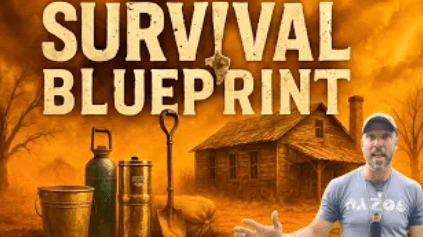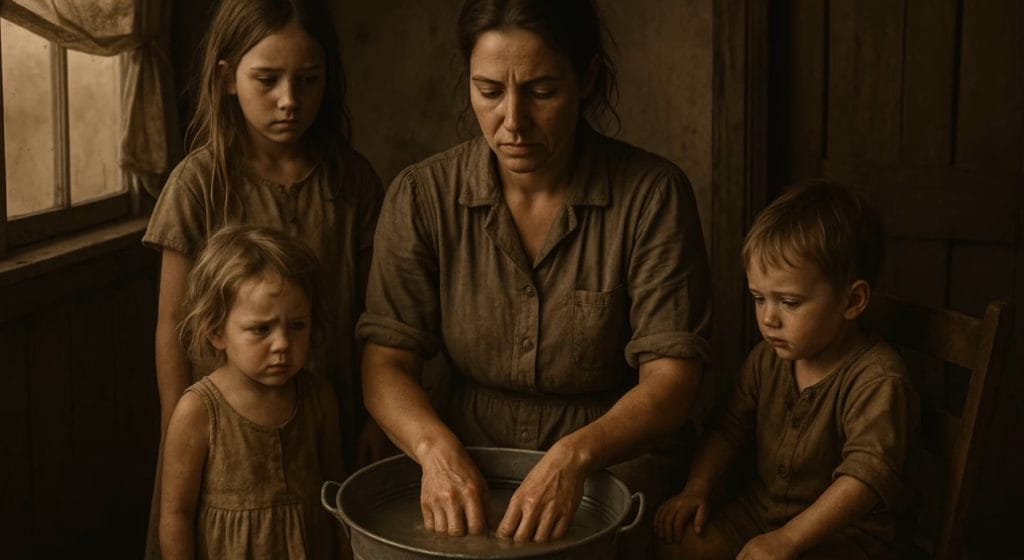
The Dust Bowl of the 1930s wasn’t the end of the world. It was a survival blueprint. Learn how ordinary people adapted, improvised, and endured one of history’s harshest disasters, and how their lessons can prepare you for whatever’s coming.
Imagine waking up one morning to a world turned gray. The sky is dark not from rain clouds but from dust. There’s grit in your teeth, dirt in your food, and every flat surface in your home is buried in a powdery film. That was daily life during the Dust Bowl of the 1930s. For many, it felt like the end of the world. But for those who endured it, the Dust Bowl wasn’t just a disaster it was a blueprint for survival.
History doesn’t just teach us what happened. It teaches us how people responded when everything fell apart. And when we look closely at the Dust Bowl, we don’t just see desperation we see resourcefulness, resilience, and timeless lessons every modern prepper should know.
This is the real story of how ordinary Americans turned one of the worst environmental crises in history into a survival masterclass and how those same principles can prepare you for whatever’s coming next.
The Dust Bowl wasn’t a single storm. It was a relentless series of droughts, dust storms, and agricultural collapse that stretched across the Great Plains for nearly a decade. Crops failed. Livestock suffocated. Families fled their homes. And on Black Sunday in April 1935, a wall of dust hundreds of feet high blotted out the sun. Visibility dropped so low that people couldn’t see their hands in front of their faces.
For many, it seemed like the apocalypse. But thousands of families stayed put and survived. They did it without modern gear, without government handouts for the most part, and without much warning. What they did have was imagination, toughness, and a refusal to quit.
The lessons they learned still apply today. Because while you might not face a dust storm, ,many of the same principles will save your life in a wildfire, chemical spill, grid-down crisis, or any long-term disaster.
The Lucas family, like many others, refused to abandon their home. Instead, they transformed their cellar into a makeshift safe zone by hanging wet sheets over windows and doors to filter out the dust. It wasn’t fancy, but it worked and that’s the first lesson of the survival blueprint: adaptation beats perfection.
Today, Ready.gov recommends sealing rooms with heavy plastic sheeting and duct tape during chemical events. The principle is the same: create clean, breathable air space using whatever you have on hand.
If wildfire smoke, chemical plumes, or fallout drift your way, improvisation will save your lungs. Wet sheets. Plastic barriers. Even basic air filters. None of it’s high-tech, but it works.
Prepper Tip: Pre-stage supplies now. Rolls of plastic, duct tape, and even old bedsheets cost almost nothing and can turn a room into a life-saving refuge.
Listen to my video on Dust Bowl Survival Here: Survival Blue Print From The Dust Bowl

The Dust Bowl wiped out crops and starved livestock across the Great Plains. Gardens withered beneath blankets of dust. Cattle suffocated. Chickens struggled to find food. For many families, the only reason they survived was because they had food stored ahead of time.
Modern preppers can learn from that mistake. You cannot rely solely on your garden, your livestock, or the grocery store. Weather, disease, or supply chain collapse can wipe them out overnight.
A smart survival blueprint includes a long-term food storage plan. Aim for at least six months, but a full year is ideal. That’s not just a prepper goal it’s peace of mind. And it’s doable for almost anyone if you start now.
Treat it like an insurance policy. Cut one unnecessary expense a daily coffee, a streaming subscription and funnel that money into shelf-stable food. Over time, those small changes build a pantry that can feed your family through almost anything.
Dust storms contaminated wells and fouled water supplies. One mother of three reportedly reused a single five-gallon bucket of water for brushing teeth, washing dishes, watering plants, and finally flushing toilets before discarding it. That’s not desperation that’s ingenuity. It may not have been the most sanitary but she was able to move forward with the daily need for water in different ways.
The reality is, one gallon per person per day is the bare minimum recommended by Ready.gov. But storing that much water for weeks or months is heavy, bulky, and expensive. That’s why redundancy matters. You need multiple water sources:
And you need a way to make that water safe. A gravity-fed water filter (e.g., Berkey), portable pump filters, purification tablets, and backup methods like boiling should all be part of your plan.
You can get some of the supplies from my Amazon Associates Store: 🛠 Amazon → My Storefront
Prepper Tip: Practice water reuse drills now. See how far you can stretch five gallons in a day. The time to figure it out isn’t during a crisis it’s before.
Physical preparation is crucial, but mindset is what separates survivors from statistics. During the Dust Bowl, people sang hymns, held church services, hosted canning parties, and shared meals. These weren’t luxuries they were lifelines for morale.
When your world shrinks to survival tasks, the weight of isolation, uncertainty, and fear can crush you. That’s why mental fortitude must be part of your preparedness plan. Train it just like any other skill.
Push yourself into discomfort. Do hard things on purpose. Sleep outside in the rain. Hike with a heavy pack. Fast for 24 hours. These experiences build resilience and resilience is contagious. If you stay calm and composed, your family will too.

No matter how strong, skilled, or prepared you are, you cannot do this alone. People who banded together during the Dust Bowl shared food, pooled resources, and supported each other. Those who tried to go it alone often didn’t make it.
That’s why building a trusted network now is essential. In my own prepper community, we use a system called T.R.U.S.T. to vet people:
A strong community multiplies your capability. One person can’t watch the perimeter, haul water, tend the garden, and teach kids at the same time. But five people working together can.
When resources vanished during the Dust Bowl, people didn’t order replacements online. They sewed clothes from feed sacks, sealed floor cracks with newspaper, and repaired tools until they literally fell apart.
That’s the difference between consumers and survivors.
Modern convenience has made many of us soft. But hard times don’t care how many Amazon boxes show up on your porch. What matters is what you can make, fix, or repurpose with your hands.
Start learning now:
Every skill you gain makes you more valuable not just to yourself but to your community. In a crisis, that value is currency.
During the Dust Bowl, livestock starved and died. Crops failed. Farmers couldn’t afford feed, and disease spread quickly. The government eventually compensated some losses, but often after animals were euthanized to prevent outbreaks.
It’s easy to take food for granted when it’s cheap and plentiful. But growing even a 50-pound bag of rice would cost you far more in time, labor, and resources than the $20 it costs at the store.
Understanding the labor behind your food builds gratitude — and motivation. It pushes you to store wisely, waste less, and produce more. It also sharpens your eye for what’s sustainable in a long-term crisis.
Some livestock simply handled the Dust Bowl better than others. Cattle suffered immensely. But chickens? They thrived — and even helped heal the soil.
For most families, chickens are the best starting livestock for preparedness. They’re low maintenance, reproduce quickly, and provide steady protein through eggs and meat. They also scavenge much of their own food and help fertilize the land.
Start small and scale up. Even a backyard flock of five or six hens can supply hundreds of eggs a year. And when they stop laying, they become another meal on your table.
If you want to go deeper into real-world preparedness join my Substack community at on3ready.substack.com. For just five bucks a month, you’ll get printable checklists, drills, and bonus guides delivered straight to your inbox. There’s a free tier too if you just want to dip your toes in.

Preppers love to talk about bugging out the trucks, the bags, the gear. But the Dust Bowl showed us something most people forget: bugging in can be just as powerful.
Thousands of families stayed put and survived through ingenuity, resilience, and problem-solving not through running away. They didn’t have luxury gear or tactical toys. They had strong minds, adaptable plans, and relentless determination.
Bugging out is sometimes necessary. But bugging in-fortifying your home, building local resilience, and preparing to endure in place, might be your greatest survival asset.
Ready.gov recommends one gallon per person per day for three days, but most preppers double that for safety. Remember, you’ll need water for cooking, cleaning, and hygiene too.
It depends on the scenario. For environmental disasters like dust storms, fallout, or chemical spills, bugging in is often safer and more sustainable. But always have a plan for both.
A year is ideal, but even three to six months puts you ahead of 95% of people. Start small and build over time.
Chickens. They require little input, reproduce quickly, provide eggs and meat, and help improve soil health.
Use a gravity-fed water filter for daily use and portable filters or purification tablets as backups. Always pre-filter dirty water through a cloth to remove debris.
Do hard things on purpose. Train in uncomfortable conditions, fast occasionally, and push your limits. Resilience is a muscle — the more you use it, the stronger it gets.
Skills first, gear second. Gear can fail, but skills don’t. Learn to sew, repair, purify water, and garden — then build your gear list around those abilities.
Look for teachable, reliable, and useful individuals who share your values. Build trust slowly, train together, and clarify expectations early.
Reuse water for multiple tasks — washing, cleaning, watering plants — before discarding it. A five-gallon bucket can serve five or more uses if rationed carefully.
Adaptability. The families who survived weren’t the wealthiest or most prepared — they were the most resourceful. They adapted quickly, improvised constantly, and refused to quit.

The Dust Bowl was more than a historical tragedy, it was proof of what humans are capable of when everything goes wrong. Families improvised air filtration with wet sheets. They reused water until the last drop. They bartered, built, repaired, and relied on each other. They didn’t just survive they endured.
And that’s the real blueprint: adapt, prepare, build community, and never stop learning. Hard times are inevitable. But the more you prepare now while the shelves are full and the power is on the easier those hard times will be when they return.
If you want to go deeper into real-world preparedness join my Substack community at on3ready.substack.com. For just five bucks a month, you’ll get printable checklists, drills, and bonus guides delivered straight to your inbox. There’s a free tier too if you just want to dip your toes in.
And for more field-tested tips and real-world survival training, subscribe to my YouTube channel On Three Survival and follow me on Instagram @jasonleesurvival.
Stay ready.
Jason Salyer
Explore the gear I personally use and trust.
Wazoo Survival Gear → Shop here (Use code GOON32025 for a discount)
Bear Forest Knives → On3 EDC | On3 Ulu | On3 Primitive
Exotac Fire Starters → Shop here (Code: On3)
PNW Bushcraft Gear → Shop here
Preparation is freedom. Do not wait for the grid to fail to figure out what you should have done. Start now. Train your body, build your get home bag, and learn how to move with confidence when everything else stops.
📩 Substack → On3Ready Newsletter
📺 YouTube → ON Three Channel
🔥 Patreon → Join On Three Community
🌲 Website → GoOn3.com
💪 Fitness → Go On Three Fitness
👕 Apparel → Shop Here

